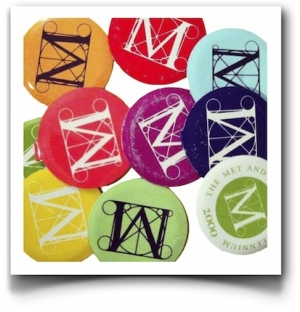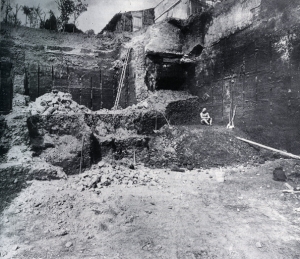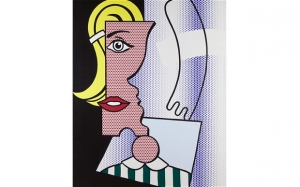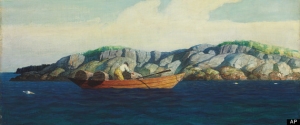|
Displaying items by tag: Metropolitan Museum of Art

In November 2012, two members of the Metropolitan Museum of Art in New York sued the institution for deceiving the public by making patrons think that the suggested admission fees are mandatory. The historically free institution suggests entry fees of $25 for adults and less for seniors and students.
Theodore Grunewald and Patricia Nicholson files the suit in state court in Manhattan and said that the museum’s fee policy lacks transparency. They also argued that the museum fails to note that the fee is suggested on several of its websites and that it’s only in fine and barely legible print on signs near cash registers. A statute was put in place in 1893 declaring that the Met must remain free in order to continue receiving government funding. Grunewald and Nicholson commissioned a survey of visitors to the museum and found that 85% of patrons believed they had to pay to gain entry.
According to court papers filed by Gerald Lee Jones, who worked at the Met as a floor manager from 2007 until 2011, cashiers were trained to deceive visitors and they were paid in part based on how much they collected from admission fees. The statement, which was filed in late June 2013, also suggested that cashiers were instructed to never volunteer that patrons may pay less than the “recommended” fee.
During the year ending in June 2012, the Met brought in $37.8 million in admissions, about 16% of the museum’s revenue.

The iconic colorful metal buttons that have served at the Metropolitan Museum of Art’s admission tickets since 1971 are no more. Due to the rising cost of the tin-plate pins, the museum will employ a new paper ticket system that will include detachable stickers, which will serve as proof of admission. The buttons will be discontinued on Monday, July 1, the same day that the Met will switch to a seven-day-a-week schedule. It was previously closed on Mondays.
The Met’s admission buttons have become a symbol of New York City culture and a popular souvenir for tourists. Their badge’s most recent iteration features an “M” appropriated from a 16th century woodcut based on a Leonardo da Vinci (1452-1519) drawing. After the Met introduced their unique admission tokens over 40 years ago, a number of institutions followed suit and they are now commonplace in museums around the world.
In addition to bringing production costs down from 3 cents per button to 1 cent per paper ticket, the new system will also be more environmentally friendly.

The Boxer at Rest, an ancient bronze sculpture from the Hellenistic period, is currently on view at the Metropolitan Museum of Art in New York. This is the first time the work has been exhibited outside of Europe as it typically resides at the Museo Nazionale Romano in Rome. The sculpture is on view in the Met’s Greek and Roman Galleries as part of the initiative 2013 – Year of Italian Culture in the United States, which is spearheaded by the Italian Ministry of Foreign Affairs.
The Boxer at Rest was discovered on the Quirinal Hill of Rome in 1885 and displayed alongside another Hellenistic bronze in the Rotunda of the Baths of Diocletian. The sculpture, which features a boxer in repose, is believes to be from somewhere between 350 B.C. and 50 B.C. It was made section-by-section and later welded together; it features copper inlays to depict the boxer’s wounds, drops of blood, and lips. The ancient bronze statue sits atop a modern stone base that is a close approximation of what the ancient base looked like.
The Boxer at Rest is one of very few original Greek bronze sculptures preserved from antiquity. The work will be on view at the Met through July 15, 2013.

Two 10th century statues that were looted from jungle temples have been returned to Cambodia by the Metropolitan Museum of Art. The Met announced in May 2013 that they would send the Khmer sculptures known as Kneeling Attendants back to Cambodia after being displayed in the museum’s Asian Wing for 10 years.
Hab Touch, director general at the Ministry of Culture, said, “The return of the statues is a historic event for us.” Seven Buddhist monks blessed the life-size statues during a religious ceremony attended by officials from the government and the Met at the airport. Upon their return to Cambodia, the sculptures will be put on display at the Peace Palace in Phnom Penh and later kept at either the National Museum in the capital or at a museum in the northwestern city of Siem Reap.
The two statues were looted from the Koh Ker temple site in the early 1970s. At the time, Cambodia was being ravaged by a brutal civil war and looting was rampant. The works were donated piece by piece to the Met in the late 1980s and 1990s. Recent documentary research revealed that the statues were in fact looted from Cambodia.
Heritage Auctions, which is based in Dallas, TX, has announced that they will be expanding their New York City office. The company has leased over 5,000-square-feet of additional space next to their current Park Avenue location. The expansion, which has tripled the auction house’s space in New York, will include an area for private sales, a showroom for exhibiting auction highlights, and a saleroom for small, on-site auctions. Heritage will continue to hold their larger sales at the Fletcher Sinclair mansion across from the Metropolitan Museum of Art.
Heritage, which was established in 1976, is currently the largest auction house specializing in collectibles such as rare coins, civil war memorabilia, fine and rare wine, and rare books and manuscripts. The auction house brought in around $900 million in sales last year.

A painting by renowned Pop artist Roy Lichtenstein (1923-1997) will be the highlight of Masterpiece London, which takes place at the Royal Hospital Chelsea from June 27 through July 3, 2013. Now in its fourth year, the show presents the finest art, antiques, and design from across the globe.
While works ranging from furniture, jewelry, and books to classic cars, watches, and whiskey will be offered, there is one particular artwork generating tons of pre-show buzz. Geoffrey Diner, a Washington, D.C.-based art dealer, will present Roy Lichtenstein’s Puzzle Portrait (1978), which has not been seen in public in 30 years and has never appeared at auction. Similar paintings are part of the Guggenheim Museum’s and the Metropolitan Museum of Art’s collections in New York. Puzzle Portrait is expected to garner around $10 million.
Diner has revealed little about the painting’s provenance other than the fact that it was sold in 1984 to “a prominent American collection.” Diner purchased the painting privately last year and the change of ownership still has not been registered in the Lichtenstein Foundation archives. The identity of the previous owners will be revealed to the buyer upon acquisition of the painting. The future buyer will also be given the personal correspondence between them and the artist from the original transaction.
On May 23, 2013, after a two and a half year renovation, the Metropolitan Museum of Art in New York unveiled 45 updated and expanded galleries of European paintings. The new space, which has increased by about a third, boasts 600 works of art dating from 1250 to 1800. Arranged in chronological order and grouped by country, the collection includes the Met’s renowned holdings of early Dutch, French, and Italian paintings.
The reimagined European painting galleries include 23 high profile loans, mainly from private collections. Works by Jan Van Eyck (1395-1441), Nicolas Poussin (1594-1665), Sandro Botticelli (1445-1510), and Peter Paul Rubens (1577-1640) will be on view for at least six months thanks to the generosity of the Met’s trustees, and patrons.
The Met’s European painting galleries have not been fully renovated since the early 1950s and this is the first overall reinstallation of the collection since 1972.

Christie’s London will offer a Rococo coffee-pot by Paul de Lamerie (1688-1751), the most celebrated British silversmith of the 18th century, as part of its Exceptional Sale on July 4, 2013. The George II silver coffee-pot, which was commissioned in 1738 by a wealthy London-based merchant, is expected to become the most valuable piece of English silver ever to be sold at auction. The masterpiece was recently the highlight of a British silver exhibition at the Metropolitan Museum of Art in New York.
Lamerie, who began his career in 1703 as an apprentice to the London goldsmith, Pierre Platel (1659-1739), opened his own workshop in 1713 and was soon appointed goldsmith to George I. His work evolved from simple Queen Anne styles to classical French designs, but his ornate Rococo works of the 1730s are his most admired pieces. Lamerie’s illustrious clientele included Sir Robert Walpole, King John V of Portugal, and Queen Elizabeth II, who he made a wedding gift for.
The coffee-pot heading to auction in July is expected to garner approximately $4.5 million.
Starting today, May 1, 2013, the Museum of Modern Art in New York will be open seven days a week. The Metropolitan Museum of Art made a similar announcement in March and will implement their week-round schedule in July.
After considerable renovations in 2004, MoMA has seen its annual visitor numbers climb from 1.5 million to 3 million. The seven-day-a-week schedule will help accommodate the museum’s growing audience. MoMA, which is located in Midtown Manhattan, is home to one of the most renowned collections of modern art including works by Paul Gauguin (1848-1903), Frida Kahlo (1907-1954), Jackson Pollock (1912-1956), Andrew Wyeth (1917-2009), and Pablo Picasso (1881-1973).
MoMA has been closed on Tuesdays since 1975, when officials introduced the tactic to cut back on museum spending. Prior to that, the museum had been open seven days a week since it’s founding in 1929.

On April 26, 2013 Christie’s announced the sale of Three Generations of Wyeth: The Collection of Eric and Cynthia Sambol, which will take place on May 23, 2013 as part of its American Art auction in New York. Comprised of thirteen works – one by N.C. Wyeth (1882-1945), six by Andrew Wyeth (1917-2009), and six by Jamie Wyeth (b. 1946) – it is one of the largest collections of Wyeths Christie’s has ever sold.
Eric Sambol, a 53-year-old New Jersey businessman, became captivated by the work of Andrew Wyeth after a school trip to the Metropolitan Museum of Art in 1976 to see the exhibition Two Worlds of Andrew Wyeth: Kuerners and Olsons. Years later in 2000, after building an impressive collection of Hudson River School and maritime paintings, Sambol acquired his first Andrew Wyeth painting, Flat Boat. With the help of his wife Cynthia, a landscape designer, the couple’s collection grew to include works by Andrew’s father, N.C. Wyeth, and Andrew’s son, Jamie Wyeth.
Highlights from the collection include Andrew Wyeth’s Rocky Hill, an emotionally wrought watercolor of his dog Nell, which is expected to garner between $1.8 million and $2.4 million; Jamie Wyeth’s Lighthouse Dandelions, which draws on the family’s close connection to Maine and is expected to sell for $250,000-$350,000; and N.C. Wyeth’s Norry Seavey Hauling Traps Off Blubber Island, which was painted as a gift to Roger Scaife, a friend of the artist and editor at Houghton Mifflin and is expected to bring $300,000 to $500,000.
|
|
|
|
|